
Edward Lear was an English artist, illustrator, musician, author and poet, who is known mostly for his literary nonsense in poetry and prose and especially his limericks, a form he popularised.

A spoon is a utensil consisting of a shallow bowl, oval or round, at the end of a handle. A type of cutlery, especially as part of a place setting, it is used primarily for transferring food to the mouth (eating). Spoons are also used in food preparation to measure, mix, stir and toss ingredients and for serving food. Present day spoons are made from metal, wood, porcelain or plastic. There are many different types of spoons made from different materials by different cultures for different purposes and food.
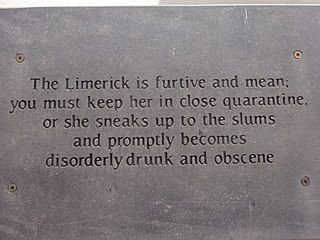
A limerick is a form of verse that appeared in Limerick, County Limerick, Ireland in the early years of the 18th century. In combination with a refrain, it forms a limerick song, a traditional humorous drinking song often with obscene verses. It is written in five-line, predominantly and amphibrach trimeter with a strict rhyme scheme of AABBA, in which the first, second and fifth line rhyme, while the third and fourth lines are shorter and share a different rhyme.

In cutlery or kitchenware, a fork is a utensil, now usually made of metal, whose long handle terminates in a head that branches into several narrow and often slightly curved tines with which one can spear foods either to hold them to cut with a knife or to lift them to the mouth.

A spork is a form of cutlery and combination utensil taking the form of a spoon-like scoop with two to four fork-like tines. Spork-like utensils, such as the terrapin fork or ice cream fork, have been manufactured since the late 19th century; patents for spork-like designs date back to at least 1874. Sporks are commonly used by fast food restaurants, schools, prisons, militaries, backpackers, and airlines.

The quince is the sole member of the genus Cydonia in the Malinae subtribe of the Rosaceae family. It is a deciduous tree that bears hard, aromatic bright golden-yellow pome fruit, similar in appearance to a pear. Ripe quince fruits are hard, tart, and astringent. They are eaten raw or processed into jam, quince cheese, or alcoholic drinks.
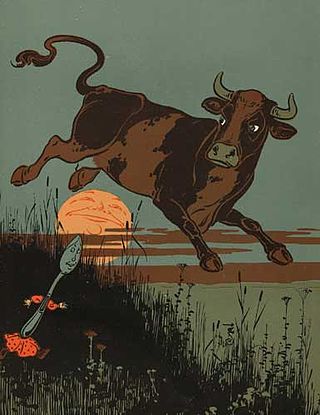
"Hey Diddle Diddle" is an English nursery rhyme. It has a Roud Folk Song Index number of 19478.
Nonsense is a form of communication, via speech, writing, or any other symbolic system, that lacks any coherent meaning. In ordinary usage, nonsense is sometimes synonymous with absurdity or the ridiculous. Many poets, novelists and songwriters have used nonsense in their works, often creating entire works using it for reasons ranging from pure comic amusement or satire, to illustrating a point about language or reasoning. In the philosophy of language and philosophy of science, nonsense is distinguished from sense or meaningfulness, and attempts have been made to come up with a coherent and consistent method of distinguishing sense from nonsense. It is also an important field of study in cryptography regarding separating a signal from noise.
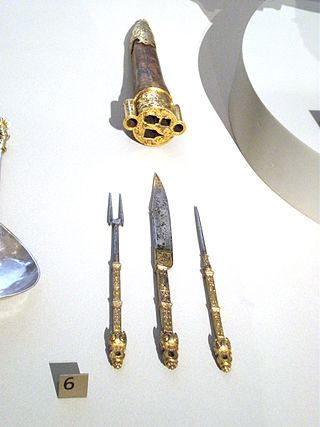
Cutlery includes any hand implement used in preparing, serving, and especially eating food in Western culture. A person who makes or sells cutlery is called a cutler. While most cutlers were historically men, women could be cutlers too; Agnes Cotiller was working as a cutler in London in 1346, and training a woman apprentice, known as Juseana.

Tableware items are the dishware and utensils used for setting a table, serving food, and dining. The term includes cutlery, glassware, serving dishes, serving utensils, and other items used for practical as well as decorative purposes. The quality, nature, variety and number of objects varies according to culture, religion, number of diners, cuisine and occasion. For example, Middle Eastern, Indian or Polynesian food culture and cuisine sometimes limits tableware to serving dishes, using bread or leaves as individual plates, and not infrequently without use of cutlery. Special occasions are usually reflected in higher quality tableware.
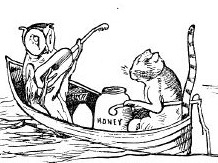
"The Owl and the Pussy-Cat" is a nonsense poem by Edward Lear, first published in 1870 in the American magazine Our Young Folks and again the following year in Lear's own book Nonsense Songs, Stories, Botany, and Alphabets. Lear wrote the poem for a three-year-old girl, Janet Symonds, the daughter of Lear's friend and fellow poet John Addington Symonds and his wife Catherine Symonds. The term "runcible", used for the phrase "runcible spoon", was invented for the poem. It is believed that the cat in the poem was based on Lear's own pet cat, Foss.
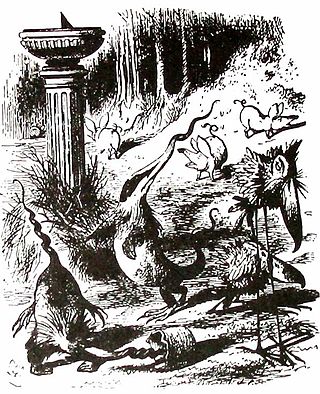
Literary nonsense is a broad categorization of literature that balances elements that make sense with some that do not, with the effect of subverting language conventions or logical reasoning. Even though the most well-known form of literary nonsense is nonsense verse, the genre is present in many forms of literature.
Nationality words link to articles with information on the nation's poetry or literature.
Nationality words link to articles with information on the nation's poetry or literature.

Elton Hayes was a British actor and guitarist.
Christian Victor Noel Hope Hely-Hutchinson was a British composer, conductor, pianist and music administrator. He is best known for the Carol Symphony and for humorous song-settings.

A grapefruit knife is a special type of knife designed specifically for cutting grapefruit. Grapefruit knives are small with a curved serrated blade, designed to hug the curves of the grapefruit. This is used to separate the outer edge of the segments from the rim of the fruit. The term "grapefruit knife" can refer to a type of knife with short, serrated twin blades about 2mm apart, used to separate the sides of each section from the dividing membrane. Some grapefruit knives incorporate both types, a double-sided curved blade on one side and the parallel twin blades on the other. Another type includes an angled tip and double sided serrated blade. When both types are used, the result is an intact-looking fruit with sections which lift out easily - especially if a "grapefruit spoon" is used.
Polly Dunbar is an English author-illustrator.

Five Childhood Lyrics is a choral composition by John Rutter, who set five texts, poems and nursery rhymes, for mixed voices a cappella. Rutter composed the work for the London Concord Singers who first performed them in 1973.

Foss, formally named Aderphos, was the pet cat of Edward Lear, the 19th-century author, artist, illustrator and poet. A "stumpy-tailed," "portly," and "unattractive" tabby cat, he was a favourite of Lear's and played an important role as a companion in the poet's lonely later years. Foss is mentioned frequently in Lear's correspondence and appears in his illustrations and at least one poem. Foss is said to have been the inspiration for the pussycat in Lear's illustrations for his poem "The Owl and the Pussycat". The funeral that Lear provided for Foss, which included an epigraphed headstone, is said to have been more elaborate than Lear's own.
















